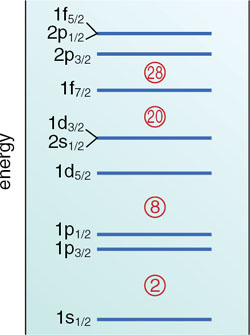8-1 | Solving for the Tricks of Magic Number Structure in Nuclei |
 |
||
|
 |
||
|
|
There exist many nuclei having not only the spherical shapes but also prolate or oblate deformed ones. Nuclear shapes are known to be well characterized by the so-called magic numbers. Generally, nuclei with proton or neutron numbers around these values are spherical and those far from such numbers become deformed. This so-called magic structure has been considered universally in nuclear structure (Fig. 8-1). Recently, greater knowledge has been accumulated about the structure of neutron-rich nuclei, i.e., those having neutron numbers much larger than those of stable nuclei. Among these, several nuclei have been found to be strongly deformed in spite of their proton/neutron number being close to a magic number. Some are found, for instance, in the region of sodium (Na) isotopes around neutron number 20. With regard to the mechanism for this deviation from the magic structure, it has been speculated that specific proton numbers tend to favor the deformation, causing a complete disruption of the coherence of protons and neutrons. No definite conclusion, however, has been reached because of the difficulty of microscopic nuclear structure calculations. In the present study, we have conducted a theoretical search for the mechanism of the disappearance using the shell model, i.e., one of the known microscopic nuclear structure calculation methods, using the Helios parallel computer system at the JAERI Tandem. We have focused on the electromagnetic moments of Na isotopes and compared them between experiment and calculation. As a result, we have established quantitatively, for the first time, that the magic structure disappears in 30Na with neutron number 19, as well as for the known case of 31Na, with neutron number 20 (Fig. 8-2). Our finding that the magic number structure already disappears at neutron number 19 cannot be explained by the simple conventional picture mentioned above. After further analysis, we have confirmed that this result cannot be reproduced under the assumption of a shell gap in neutron-rich nuclei which is as large as that in stable ones. Thus, it turned out that one of the contributing mechanisms was the strong dependence of the shell gap on proton/neutron number, probably reflecting the microscopic nature of the nuclear force [1]. Following the results of the present study, it is predicted that the magic structure also disappears for the magnesium (Mg) isotope with neutron number 19. This prediction has been confirmed recently by comparing a measurement of the magnetic moment of 31Mg with our calculated value [2]. |
|
References
[1] Y. Utsuno et al., Onset of Intruder Ground State in Exotic Na Isotopes and Evolution of the N=20 Shell Gap, Phys. Rev. C, 70(4), 044307 (2004). [2] G. Neyens et al., Measurement of the Spin and Magnetic Moment of 31Mg: Evidence for a Strongly Deformed Intruder Ground State, Phys. Rev. Lett., 94(2), 022501 (2005). |
| Select a topic in left column |
|
|
Persistent Quest Research Activities 2005
Copyright (C) Japan Atomic Energy Research Institute |